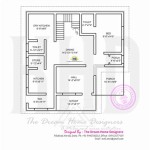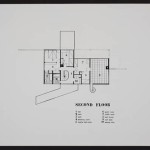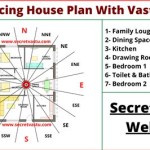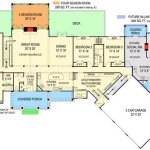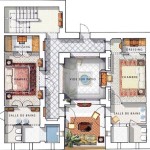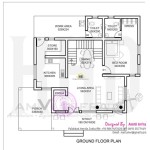4 Bedroom House Plans and Cost to Build
Constructing a new home is a significant undertaking, requiring meticulous planning and careful consideration of various factors. For many growing families or individuals desiring extra space, a 4-bedroom house plan represents an ideal solution. This type of design offers ample room for living, working, and accommodating guests. However, understanding the associated costs involved in building a 4-bedroom house is crucial for effective budgeting and project management. This article delves into the intricacies of 4-bedroom house plans and explores the factors influencing the overall cost of construction.
The appeal of a 4-bedroom house lies in its versatility. These homes can comfortably accommodate families of varying sizes, provide dedicated spaces for home offices or hobby rooms, and offer increased resale value compared to smaller properties. The availability of diverse architectural styles and customizable floor plans allows homeowners to tailor the design to their specific needs and preferences. Before embarking on the construction process, it's essential to analyze individual requirements and explore different plan options to determine the most suitable design for your lifestyle and budget.
Understanding 4-Bedroom House Plans
4-bedroom house plans encompass a wide spectrum of designs, ranging from single-story ranch-style homes to multi-story contemporary structures. The layout, square footage, and architectural style significantly impact the overall functionality and aesthetic appeal of the house. Common layouts include:
Ranch Style: Typically single-story, offering ease of accessibility and often featuring an open floor plan. This style is ideal for those seeking simplicity and minimal stairs.
Two-Story: Maximizes living space by stacking floors, often featuring bedrooms on the upper level and living areas on the ground floor. This design is well-suited for smaller lots and can provide increased privacy.
Split-Level: Characterized by staggered floor levels connected by short flights of stairs. This design can create distinct zones for different activities and offer a unique architectural aesthetic.
Contemporary: Embraces modern design elements such as clean lines, large windows, and open floor plans. This style often incorporates sustainable materials and energy-efficient features.
The square footage of a 4-bedroom house can vary considerably, typically ranging from 1,800 to 3,000 square feet or more. The size of the house should be determined by the number of occupants, lifestyle needs, and the size of the building lot. It is important to find a balance between having adequate space and managing construction costs effectively.
When selecting a 4-bedroom house plan, consider factors such as the location of bedrooms (e.g., master suite separation for privacy), the flow between living areas, the size and layout of the kitchen, and the inclusion of features such as a home office, mudroom, or outdoor living space. Working with an architect or experienced home designer can help translate your vision into a functional and aesthetically pleasing design.
Factors Influencing the Cost to Build
The cost to build a 4-bedroom house is influenced by a multitude of factors, making it challenging to provide a precise estimate without considering specific details of the project. These factors can be broadly categorized into the following key areas:
Location: Geographic location is a primary driver of construction costs. Labor rates, material prices, and permitting fees can vary significantly from one region to another. Areas with high demand and limited availability of skilled labor tend to have higher construction costs.
Materials: The choice of building materials significantly impacts the overall cost. High-end finishes, such as hardwood flooring, granite countertops, and custom cabinetry, will increase costs compared to more economical options. The selection of roofing materials, siding, and windows also plays a significant role.
Labor: Labor costs account for a substantial portion of the total construction budget. The complexity of the design, the availability of skilled tradespeople, and the prevailing wage rates in the area all influence labor expenses. Hiring experienced and reputable contractors is essential to ensure quality workmanship and minimize potential delays or rework.
Design Complexity: Intricate architectural details, custom features, and unusual layouts can increase construction costs. Simple, straightforward designs tend to be more cost-effective to build. Consider the impact of the design on the overall budget and prioritize essential features over unnecessary embellishments.
Size and Square Footage: Generally, the larger the house, the higher the construction cost. Each additional square foot requires more materials, labor, and time to complete. Optimize the design to maximize functionality within a reasonable square footage to control costs.
Permits and Fees: Obtaining the necessary permits and paying associated fees is a mandatory part of the construction process. Permit costs can vary depending on the location, the size of the house, and the complexity of the project. Factor these expenses into the overall budget.
Site Conditions: The condition of the building site can significantly impact construction costs. Difficult terrain, soil instability, or the presence of underground utilities can require additional site preparation work, increasing expenses. Conducting a thorough site assessment before starting construction is crucial.
Fixtures and Appliances: The selection of plumbing fixtures, lighting fixtures, appliances, and other interior elements will affect the overall cost. High-end brands and energy-efficient models typically come with a higher price tag. Consider the long-term benefits of investing in quality fixtures and appliances, such as reduced energy consumption and increased durability.
Estimating the Cost to Build a 4-Bedroom House
While providing a definitive cost estimate without project-specific details is impossible, there are several methods for estimating the cost to build a 4-bedroom house. These methods range from simple rules of thumb to more detailed cost breakdowns.
Cost per Square Foot: This method involves multiplying the square footage of the house by an estimated cost per square foot. The cost per square foot can vary depending on the location, materials, and level of finishes. Researching recent construction projects in the area can provide a general idea of the prevailing cost per square foot.
Detailed Cost Breakdown: A more accurate approach involves creating a detailed cost breakdown that includes estimates for each aspect of the construction process, such as site preparation, foundation, framing, roofing, plumbing, electrical, HVAC, finishes, and landscaping. This method requires gathering quotes from multiple contractors and suppliers to obtain accurate pricing information.
Professional Cost Estimator: Hiring a professional cost estimator can provide a more precise and reliable estimate. Cost estimators have expertise in analyzing construction plans, assessing material and labor costs, and accounting for potential contingencies. Their services can help minimize the risk of cost overruns and ensure that the project stays within budget.
It is crucial to remember that any cost estimate is just that – an estimate. Unforeseen circumstances, such as material price fluctuations or unexpected site conditions, can impact the actual cost of the project. It is prudent to include a contingency fund in the budget to account for such surprises.
Furthermore, the type of contract utilized for the project impacts costs and risk allocation. Common contract types include:
Fixed-Price Contract: The contractor agrees to complete the project for a predetermined price. This provides cost certainty but may limit flexibility. The contractor bears the risk of cost overruns.
Cost-Plus Contract: The homeowner pays the contractor for the actual cost of materials and labor, plus a predetermined fee. This provides transparency but less cost certainty. The homeowner bears the risk of cost overruns, though is able to see where costs are accruing.
Guaranteed Maximum Price (GMP) Contract: The contractor agrees to complete the project for a price not exceeding a predetermined maximum. Any savings below the maximum are typically shared between the homeowner and the contractor. This provides a balance between cost certainty and flexibility.
Selecting the appropriate contract type is critical for managing costs and ensuring the successful completion of the project.
Building a 4-bedroom house is a significant investment that requires careful planning and budgeting. By understanding the different types of house plans available and the factors influencing construction costs, homeowners can make informed decisions and create a home that meets their needs and fits their budget. Engage with experienced professionals, obtain multiple quotes, and develop a detailed budget to navigate the construction process effectively. Diligent planning and meticulous execution are key to achieving a successful and satisfying outcome.

Est House Plans To Build Simple With Style Blog Eplans Com

Building On The Affordable House Plans Of 2024 Houseplans Blog Com

Est House Plans To Build Simple With Style Blog Eplans Com

4 Bedroom House Plan Examples
Est House Plans To Build Simple With Style Blog Eplans Com

Low Budget Simple House Design Plans For Builders Blog Builderhouseplans Com

House Plan 45467 Ranch Style With 1680 Sq Ft 4 Bed 2 Bath

40 039 X 60 Modern House Architectural Plans 4 Bedroom

Get The Lowdown On Cost To Build Estimates Houseplans Blog Com
Affordable House Plans Our Est To Build Blog Homeplans Com

